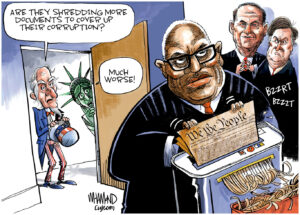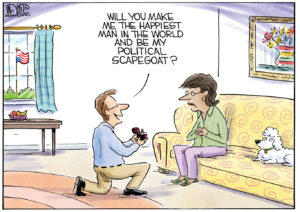Scuttling ‘New York Times v. Sullivan’ Could Destroy Independent Media
The foundational precedent protecting freedom of the press may be on shaky ground. Clarence Thomas, Sarah Palin, and Donald Trump. Graphic by Truthdig. Images via AP Photo / Adobe Stock
Clarence Thomas, Sarah Palin, and Donald Trump. Graphic by Truthdig. Images via AP Photo / Adobe Stock
What do Donald Trump, Clarence Thomas and Sarah Palin have in common on the First Amendment? All three are pushing for the Supreme Court to overturn New York Times v. Sullivan, the 1964 landmark decision on defamation, the First Amendment and freedom of the press.
Prior to Sullivan, defamation lawsuits were governed by state law rather than the First Amendment. They were routinely used by the wealthy and powerful to stifle political criticism and quash public debate on important issues. To prevail, plaintiffs only had to establish “a preponderance of the evidence” — the lowest standard of proof in our legal system — that they had sustained reputational damage because of a defendant’s written or verbal statements. Defendants could escape liability only if they showed their statements were true in all material respects.
Sullivan constitutionalized the law of defamation by establishing a new test under the First Amendment for defamation lawsuits brought by public officials known as the “actual malice” rule. Under the new rule, public officials would henceforth be required to show by “clear and convincing evidence” (a far more stringent standard of proof) that defamatory statements about them, even if untrue, were made with “actual malice” — that is, that they were made with the knowledge that they were false or with reckless disregard for the truth.
The Supreme Court adopted the actual malice test unanimously. Writing for the majority, Justice William Brennan, one of the great liberals of the Warren Court era, explained that constitutional protections for journalists, publishers and other speakers were essential to safeguard our “profound national commitment” to “uninhibited, robust and wide-open debate,” even when the debate “includes vehement, caustic and sometimes unpleasantly sharp attacks.”
Sullivan constitutionalized the law of defamation by establishing a new test under the First Amendment for defamation lawsuits brought by public officials known as the “actual malice” rule.
Sullivan was a product of the civil rights movement and a high court that had its eyes on the future and the possibility of fostering a fairer and most just society.
On March 29, 1960, the New York Times published a full-page advertisement paid for by the Committee to Defend Martin Luther King and the Struggle for Freedom in the South. Titled “Heed Their Rising Voices,” the ad sought to raise money to defend MLK against perjury charges that had been brought against him in Montgomery, Ala., and to call attention to acts of police brutality committed against student protesters who had answered MLK’s call for nonviolent demonstrations in cities and colleges across the South.
Although the ad was largely accurate, it contained a few mistakes, such as its claim that Montgomery officials had padlocked the dining hall at Alabama State College to starve and intimidate student activists. Three Montgomery officials, led by Public Affairs Commissioner L.B. Sullivan, who supervised the city’s police, seized on the error, and sued the Times and four Black ministers whose names appeared on the ad for defamation. Six months later, an all-white jury in Montgomery returned a $500,000 verdict in Sullivan’s favor, then the largest-ever libel verdict in the country’s history.
Sullivan’s success gave rise to copycat litigation with additional lawsuits filed against the Times, the Associated Press, the Saturday Evening Post and other publications. By 1964, according to the Knight First Amendment Institute at Columbia University, Southern officials had brought 17 libel complaints against Northern media outlets seeking damage awards of more than $288 million, a staggering sum at the time. The litigation was part of a broad strategy employed by Southern racists to use the courts to bankrupt newspapers that were covering the civil rights movement, and in the process undermine the movement itself.
The strategy might have worked but for the involvement of the Warren Court and the approval of the actual malice rule. The court set aside the verdict in favor of Sullivan, and in a 1967 decision, extended the rule to “public figures” (those in the private sector who wield pervasive power and influence). In 1986, the court expanded the doctrine again to include private figures in cases involving the media’s reporting on matters of public concern. As the legal commentator Adam Cohen has written, “The regime New York Times v. Sullivan established was about giving the media ‘breathing space’ to do journalism without fear of being sued into oblivion.”
That regime is now under threat from the aforementioned motley crew of Trump, Thomas and Palin. Trump jump-started the current assault at a campaign rally in Fort Worth, Texas, on Feb. 26, 2016. Speaking before a throng of enthralled MAGA cultists, he declared:
“I think the media is among the most dishonest groups of people I have ever met. They’re terrible. … One of the things I’m going to do if I win, and I hope I do and we’re certainly leading, is I’m going to open up our libel laws so when they [the media] write purposefully negative and horrible and false articles, we can sue them and win lots of money. We’re going to open up those libel laws.”
Although Trump failed in his quest during his first term in office, he continued to demonize the press as the “enemy of the people,” and began a trend that continues to this day, threatening to jail offending journalists. Trump renewed his attack on Sullivan in a 2022 lawsuit against CNN, alleging that the network had used the term “Big Lie” in connection with the 2020 election to equate him with Adolf Hitler. (The suit has since been dismissed.)
Trump’s efforts might be regarded as ineffectual bluster, but for the intervention of Thomas, who in a 2019 concurring opinion urged the Court to reconsider Sullivan, calling the ruling and the court’s other defamation precedents “policy-driven decisions masquerading as constitutional law.” In 2021, Neil Gorsuch joined Thomas, writing that “momentous changes in the Nation’s media landscape since 1964” may be reason to reconsider Sullivan.
It would only take three more votes on the court to consign Sullivan to the same dustbin as Roe v. Wade, which the court jettisoned in 2022. There is no reason to believe that Samuel Alito, Brett Kavanaugh and Amy Coney Barrett would not join Thomas and Gorsuch in such an undertaking if presented with a proper test case, particularly if given political cover by a reelected and emboldened Trump.
It would only take three more votes on the court to consign Sullivan to the same dustbin as Roe v. Wade, which the court jettisoned in 2022.
That’s where Sarah Palin comes in. In 2017, Palin sued the New York Times for defamation, alleging the paper had defamed her and damaged her career as a political commentator by running an editorial on gun control that suggested a connection between the former GOP vice presidential candidate’s political action committee and the 2011 mass shooting in Arizona that left six people dead and severely injured Rep. Gabby Gifford, D-Ariz.
In 2022, a New York City jury rejected Palin’s suit after being instructed on the law of actual malice. In a surprise ruling on Aug. 28, however, the Second Circuit Court of Appeals reversed the judgment on technical grounds, and remanded the case for a new trial.
Should Palin lose her retrial, she will eventually turn to a Supreme Court that can no longer be trusted to follow precedents in conflict with the demands and interests of its GOP benefactors and overseers. If Sullivan falls, whether in Palin’s case or in another legal challenge, it won’t just be mainstream outlets like the Times and the Washington Post that will suffer the consequences. Overruling Sullivan will be an existential catastrophe for small independent publishers who, much like the civil rights crusaders of the ‘60s, can ill afford to engage in costly litigation.
The preservation of Sullivan should be seen not just as a legal issue; it is a political issue that will determine the future of the First Amendment. Defeating Trump in November may not guarantee the landmark ruling’s survival, but his reelection will undoubtedly turn up the clamor for its demise.
Your support matters…Independent journalism is under threat and overshadowed by heavily funded mainstream media.
You can help level the playing field. Become a member.
Your tax-deductible contribution keeps us digging beneath the headlines to give you thought-provoking, investigative reporting and analysis that unearths what's really happening- without compromise.
Give today to support our courageous, independent journalists.








You need to be a supporter to comment.
There are currently no responses to this article.
Be the first to respond.